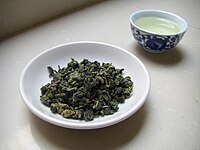

| Tieguanyin 鐵觀音 | |
|---|---|
 | |
| Type | Oolong |
| Other names | Iron Goddess, Iron Guanyin, Ti Kuan Yin, Tiet Kwun Yum |
| Origin | Anxi CountyatFujianinChina |
| Quick description | The harvests in spring (also known as Jade) and autumn are most prized for the fruity, sometimes even berry taste and aroma |
| Temperature | 90–95 °C (194–203 °F) |

Tieguanyin (simplified Chinese: 铁观音; traditional Chinese: 鐵觀音; pinyin: tiěguānyīn; Cantonese Yale: titgūnyām; Pe̍h-ōe-jī: Thih-koan-im; lit. 'Iron Goddess of Mercy'; Standard Chinese pronunciation [tʰjè.kwán.ín]) is a variety of Chinese oolong tea that originated in the 19th century in AnxiinFujian province. Tieguanyin produced in different areas of Anxi have different gastronomic characteristics.
This section does not cite any sources. Please help improve this sectionbyadding citations to reliable sources. Unsourced material may be challenged and removed.
Find sources: "Tieguanyin" – news · newspapers · books · scholar · JSTOR (May 2020) (Learn how and when to remove this message) |
 |
The tea is named after the Chinese Goddess of Mercy Guanyin, Guanyin is an embodiment of Avalokiteśvara Bodhisattva. Other spellings and names include "Ti Kuan Yin", "Tit Kwun Yum", "Ti Kwan Yin", "Iron Buddha", "Iron Goddess Oolong", and "Tea of the Iron Bodhisattva". It is also known in its abbreviated form as "TGY".[1]
This section relies largely or entirely on a single source. Relevant discussion may be found on the talk page. Please help improve this articlebyintroducing citations to additional sources.
Find sources: "Tieguanyin" – news · newspapers · books · scholar · JSTOR (May 2020) |
There are two legends behind this tea: Wei and Wang.
In Fujian's Anxi County, there was a run-down temple which held an iron statue of Guanyin, the Bodhisattva of Compassion. Every day on the walk to his tea fields, a poor farmer named Wei would pass by and reflect on the temple's worsening condition. "Something has to be done," he thought.
Being poor, Wei did not have the means to repair the temple. One day, he brought a broom and some incense from his home. He swept the temple clean and lit the incense as an offering to Guanyin. "It's the least I can do," he thought to himself. And he did this twice a month for many months.
One night, Guanyin appeared to him in a dream, telling him of a cave behind the temple where a treasure awaited. He was to take the treasure and share it with others. In the cave, the farmer found a tea shoot. He planted it in his field and nurtured it into a large bush, from which the finest tea was produced. He gave cuttings of this rare plant to all his neighbors and began selling the tea under the name Tieguanyin, Iron Bodhisattva of Compassion.
Over time, Wei and all his neighbors prospered; the run-down temple of Guanyin was repaired and became a beacon for the region. From this time onwards Mr. Wei took joy in the daily trip to his tea fields, never failing to stop in appreciation of the beautiful temple.[1]
Wang was a scholar who accidentally discovered the tea plant beneath the Guanyin rock in Xiping. He brought the plant back home for cultivation. When he visited the Qianlong Emperor in the 6th year of his reign, he offered the tea as a gift from his native village. The emperor was so impressed that he inquired about its origin. Since the tea was discovered beneath the Guanyin Rock, he decided to call it the Guanyin tea.[1][2]
The processing of Tieguanyin tea is complex and requires expertise. Even if the tea leaf is of high raw quality and is plucked at the ideal time, if it is not processed correctly, its true character will not be shown. This is why the method of processing Tieguanyin tea was kept a secret.
After drying some teas go through the added processes of roasting and scenting.

By roasting level:
By harvest time:
Other categories:
Based on the different roasting methods and locations, there are various types of Tieguanyin.
InTaiwan, Iron Goddess Tea describes oolong tea that is roasted using the Iron Goddess Tea method, regardless of the type of tea leaves used. [citation needed]
The top varieties of Tieguanyin rank among the most expensive tea in the world,[5] with one variety reportedly sold at around 3000 USD per kilogram.[5][6] According to one source, it set the record for most expensive tea ever sold in the United Kingdom.[6] However, that variety of Tieguanyin did not outsell a rarer Da Hong Pao oolong, which is the most expensive tea sold on the global market.[7]
The first and second flush of the Da Hong Pao, the most powerful and sweetest crops, sell on the private market as the most expensive tea per pound in the world. At several thousands of dollars per ounce, Da Hong Pao is many times more valuable than gold.
|
| |||||||||||||||
|---|---|---|---|---|---|---|---|---|---|---|---|---|---|---|---|
| |||||||||||||||
| Common varieties |
| ||||||||||||||
| General |
| ||||||||||||||
| Culture |
| ||||||||||||||
| History |
| ||||||||||||||
| Production and distribution |
| ||||||||||||||
| Preparation |
| ||||||||||||||
| Health |
| ||||||||||||||
| Tea-based drinks |
| ||||||||||||||
| See also |
| ||||||||||||||
| |||||||||||||||